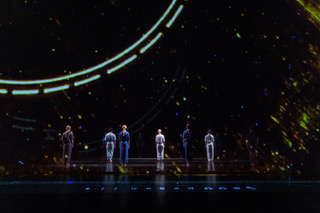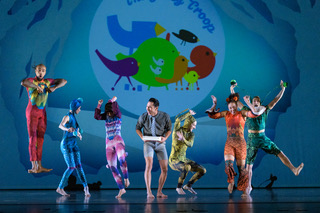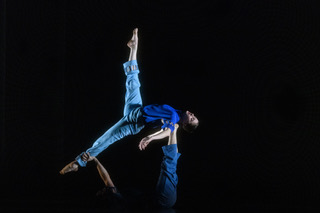EDITOR’S NOTE: Mark Alvarez, an immigration attorney who also has written for various publications on many subjects along with radio and television appearances, is the guest reviewer for the Ririe-Woodbury Dance Company’s Allegory concert, which he and his family attended recently as part of the company’s Moving Parts Family Matinee Series. His review is presented in Spanish and English.
SPANISH VERSION:
La tropa alegre de seis pájaros vestidos en los colores del arco iris bailaron por el tablado amplio del Teatro Capitol e recogieron páginas azules del suelo para agregar a un libro grande del cual se emanaba luz. Sujetando el libro, el narrador caminó, paró para encarar a la audiencia y preguntó:
¿Qué historia tienes para contar?
¿Estás listo para contarla?
Unas páginas de muchos colores se cayó de cielo al tablado al final de la actuación de La criatura viva y las cosas etéreas (the live creature & ethereal things, en inglés).

Antes de comienzo de la obra, una pantalla grande al fondo del escenario pasaba iconos y párrafos en inglés y español. El texto se pasó demasiado rápido para entender a primera vista, pero se repetía. Con tiempo, se podía captar los nombres de personajes y explicaciones sobre sus historias particulares. La audiencia aprendió que a Algernón de color verde le gustaba la comida de color verde. Magnus de color amarillo tenía la diversión de estudiar la historia. Penny de color púrpura solía correr a todos lados. A Yvette le encantaba París.
La obra se arrancó con el narrador abriendo el libro grande que emitía luz. El narrador empezó a contar la historia de un pájaro de color púrpura que bailaba. Durante cuarenta minutos de la actuación, los seis pájaros de la tropa alegre bailaron a una música maravillosa mientras la pantalla al fondo del escenario proyectaba sus colores y algunos paisajes e imágenes que reforzaron los temas y la dirección de la historia. En un momento, las estrellas se colgaba de los hilos. En otro momentos, unas imágenes de agua daba el contexto mientras los pájaros se bajaron del cielo en busca de comida.
La obra se componía de una mezcla de música, baile, película, teatro musical e literatura. Los bailes incluyeron una variedad de maniobras e estilos. Estaba claro en la interacción de los componentes de la tropa alegre que había mucha conexión entre si, un punto que se ilustraba cuando dos pájaros levantaron y llevaron a otro que se había lesionado o caído en un desafío físico que le había dejado sin fuerza.

El narrador hablaba y cantaba en inglés y en español para embellecer las historias de amistad y para invitar a la audiencia pensar en bailar en el aire e imaginar como sería tener la vida de un pájaro que volaba por los aires. Se veía claro que el talento y la energía de la tropa alegre llegaron a una audiencia que superaba con diferencia una centena de niños y más adultos que se quedaron después de la obra para hablar con los artistas individuales y pedir sus autógrafos.
Durante un intermedio corto de Moving Parts Family Series, Daniel Charon, coreógrafo y director artístico de Ririe-Woodbury Dance Company, habló sobre algunas cualidades del baile, unos movimientos suaves, casi flotantes, y otros más bruscos. Daniel Charon invitó a la audiencia mover los brazos como si fueran las alas de los pájaros. Se funcionaba para ayudar a la audiencia imaginar volar como un pájaro. Daniel Charon también puso el contexto para Aberraciones de luz (Aberrations of Light, en inglés), inspirado en el libro Pale Blue Dot de científico Carl Sagan.
En Aberraciones de luz, los seis componentes de la tropa alegre participaron. Once bailadores de Utah Valley University también participaron. Todos se vestían en tonos de azul, detrás de una pantalla trasluciente que proyectaba símbolos, imágenes y luz. Los diecisiete bailadores usaba todo el tablado para combinaciones artísticos mientras visiones de radar y nieve flotando hacia arriba para delante en la pantallas. Casi al final de la obra de quince minutos, se levantaba la pantalla para descubrir más a los bailadores y un punto azul pálido en la pantalla al fondo del escenario.
The Moving Parts Family Series (un programa especial para familias) se destacó por la gracia y la generosidad de los bailadores y el coreógrafo que salieron después de la obra para hablar con miembros de la audiencia y firmar los programas. El coreógrafo dijo que más de cinco mil estudiantes de la primaria había visto la obra. Se veía claramente que los artistas se llevaban bien con todos los niños y que a todos les gustaban la experiencia.

ENGLISH VERSION:
The Jolly Troop of six birds, beautifully costumed in colors of the rainbow, danced around the large Capitol Theatre stage and collected purple pages from the ground to add to an oversized book emanating light. Holding the book, the narrator wandered, stopped to face the audience and asked:
What story do you have to tell?
Are you ready to tell it?
Multicolored pages floated down to the stage, as a matinee performance of excerpts from the live creature & ethereal things ended.
Before the show, paragraphs in English and Spanish along with icons moved quickly across a screen at the back of a stage. They passed too quickly to be read at first glance, but they could be captured over time as background on characters named Algernon, Magnus, Penny, Red Fred, Stilts, Yvette and Dred Fred. We learned that the green Algernon liked green food, yellow Magnus liked to study history, purple Penny liked to run everywhere and orange Yvette liked Paris.
The show began with the narrator opening the oversized book that lit up and telling the story of a purple pájaro who danced around the stage. Over the forty minutes of the performance, individual birds came out to dance to wonderful music as a screen at the back of the stage matched their color and shifted landscapes from desert to water to space to fit the direction of the story. At one point, stars looked to be suspended on strings. The water appeared as the birds moved as if diving toward their food.
The dance included joyful lifts and much interaction among The Jolly Troop that plainly cared for each other, a point illustrated when two birds hoisted another who had been injured or was facing some form of physical challenge, referential to the Red Fred Project that served as inspiration for the work.
The narrator spoke and sang in English and Spanish to enhance the stories of friendship and invite the audience to think about dancing on air and to imagine what it would be like to be a bird, perhaps what it would be like to soar.
During a short intermission during the Moving Parts Family Series, Daniel Charon, choreographer and the artistic director of Ririe-Woodbury Dance Company, talked about watching for floating qualities in the dancing as well as for jagged actions. Daniel Charon involved the audience in using its arms like wings, to help imagine flying like a bird. The work was a magnificent collaboration with the Flying Bobcat Theatrical Laboratory and the Red Fred Project. With the storyline guidance of Alexandra Harbold from the Flying Bobcat Theatrical Laboratory, an original musical score by John Paul Hayward, and text and lyrics by New York playwright Troy Deutsch, the work brings to life in dance the characters of the Jolly Troop that form the core of the stories created in the Red Fred Project. Tito Livas was the guest artist as narrator, using Spanish and English.
He also set the context for Aberrations of Light, which was inspired by Carl Sagan’s book Pale Blue Dot: A Vision of the Human Future in Space.

Aberrations of Light involved the company dancers as well as 11 guest artists from Utah Valley University, who performed, costumed in various shade of blue, behind a front screen that projected symbols and light. The dancers made use of the broad stage for numerous and graceful combinations as radar images and snow floating diagonally upward flashed passed by in front. Near the end, the front screen lifted to give way to the pale blue dot on the screen at the back of the stage.
The Moving Parts Family Series was made especially marvelous by the dancers and the choreographer who came out, talked with and signed autographs for more than one hundred adults and children after the performance. Tito Livas, who played the narrator, spoke to my six-year-old son Tanner. Tanner spoke a little Spanish, and the actor responded that Tanner might be able to give lessons. Another young child told a dancer that she was not sure what everything meant. The dancer responded: “I get that.” Daniel Charon mentioned that 5,000 to 6,000 K-6 elementary school students had seen the live creature & ethereal things. It was evident in their grace and generosity that the dancers have had ample experience with students and younger audiences.
